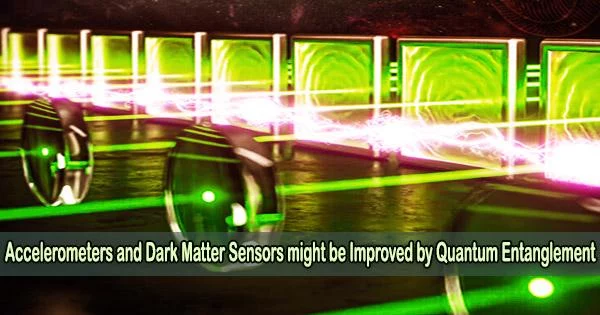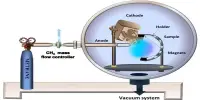The “spooky action at a distance” that once alarmed Einstein may soon become as commonplace as the gyroscopes used in today’s smartphones to monitor acceleration. A recent study published in Nature Photonics shows that quantum entanglement dramatically increases the accuracy of sensors that can be used to navigate without GPS.
“By exploiting entanglement, we improve both measurement sensitivity and how quickly we can make the measurement,” said Zheshen Zhang, associate professor of electrical and computer engineering at the University of Michigan and co-corresponding author of the study.
The experiments were done at the University of Arizona, where Zhang was working at the time.
A mechanical sensing device that moves in reaction to disturbances is measured by optomechanical sensors. That motion is then measured with light waves. The sensors used in this experiment were membranes, which respond to pressure by vibrating like drum heads.
Optomechanical sensors have the ability to act as accelerometers, which can be utilized for inertial navigation on a planet without GPS satellites or while moving between floors of a building.
Optomechanical sensors may be more accurate than currently used inertial sensors thanks to quantum entanglement. Additionally, it might make it possible for optomechanical sensors to search for incredibly subtle forces, such as the presence of dark matter.
Dark matter is invisible matter that is thought to make up five times more of the universe’s mass than what we can see with our eyes. It would tug on the sensor with gravitational force.
It is envisioned that an array of entanglement-enhanced sensors will offer orders-of-magnitude performance gain over existing sensing technology to enable the detection of particles beyond the present physical model, opening the door to a new world that is yet to be observed.
Professor Zheshen Zhang
Here’s how entanglement improves optomechanical sensors:
Optomechanical sensors rely on two synchronized laser beams. One of them is reflected from a sensor, and if the sensor moves, the light’s path to the detector is altered. The second wave’s overlap with the first wave causes that difference in distance traveled to become apparent. If the sensor is still, the two waves are perfectly aligned.
The peaks and troughs of their waves, however, interfere with one another when the sensor is moving, producing an interference pattern. That pattern reveals the size and speed of vibrations in the sensor.
Typically, the longer the light travels, the more precise the interferometry system becomes. The most sensitive interferometry system on the planet, the Laser Interferometer Gravitational-Wave Observatory, sends light on 8-kilometer journeys. But that’s not going to fit in a smartphone.
To enable high accuracy in miniaturized optomechanical sensors, Zhang’s team explored quantum entanglement. They divided each beam twice so that the light rebounded off two sensors and two mirrors instead of only splitting it once so that it hit a sensor and a mirror. Dalziel Wilson, an assistant professor of optical sciences at the University of Arizona, along with his doctoral students Aman Agrawal and Christian Pluchar, built the membrane devices.
These membranes, just 100 nanometers or 0.0001 millimeters thick, move in response to very small forces.
Since the membranes should be vibrating in unison, doubling the sensors increases accuracy, but entanglement adds an additional layer of coordination. Zhang’s group created the entanglement by “squeezing” the laser light.
The degree to which the position and momentum of a particle may be known with certainty in quantum mechanical systems, such as the photons that make up light, is fundamentally constrained. Because photons are also waves, this translates to the phase of the wave (where it is in its oscillation) and its amplitude (how much energy it carries).
“Squeezing redistributes the uncertainty, so that the squeezed component is known more precisely, and the anti-squeezed component carries more of the uncertainty. We squeezed the phase because that is what we needed to know for our measurement,” said Yi Xia, a recent Ph.D. graduate from Zhang’s lab at the University of Arizona and co-corresponding author of the paper.
In squeezed light, the photons are more closely related to one another. Zhang compared what transpires when photons pass through a beam splitter with vehicles approaching a freeway fork.
“You have three cars going one way and three cars going the other way. But in quantum superposition, each car goes both ways. Now the cars on the left are entangled with the cars on the right,” he said.
The uncertainties in the two entangled beams’ fluctuations are correlated, which also applies to the uncertainties in the measurements of their phase. The team was able to obtain measurements that are 60% faster and 40% more accurate than they could with two unentangled lasers thanks to some mathematical wizardry. What’s more, the precision and speed is expected to rise in proportion to the number of sensors.
“It is envisioned that an array of entanglement-enhanced sensors will offer orders-of-magnitude performance gain over existing sensing technology to enable the detection of particles beyond the present physical model, opening the door to a new world that is yet to be observed,” said Zhang.
The team’s next steps are to miniaturize the system. They can currently fit a squeezed light source on a chip with a side length of only half a centimeter. Within a year or two, they want to have a prototype chip equipped with the squeezed-light source, beam splitters, waveguides, and inertial sensors.















